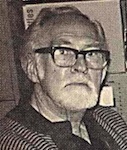Stan Pitt's first published work was the science-fiction comic book, Anthony Fury, written by Frank Ashley (q.v.), and published by Consolidated Press (ca.1942). Working again with Ashley, Pitt undertook his next project, 'Universal Conquest', which was serialised in Star Pocket Comics (Frank Johnson Publications, ca.1942-1945). Featuring Nelson Power, the central character from 'Universal Conquest', Ashley and Pitt subsequently proposed a full-colour comic book, 'Nelson Power Conquers the Universe' (unpublished, ca.1945).
While employed as an illustrator on comic strip advertisements for Colgate-Palmolive in 1945, Pitt was noticed (for his comic book artwork) by a colleague at the George Patterson (q.v.) advertising agency. As a result, a meeting was arranged between Pitt and Eric Kennedy, Chief Executive Officer, Associated Newspapers. Kennedy was intrigued by 'Silver Starr' (a minor character appearing in the 'Nelson Power' comic) and commissioned Pitt to produce a full-colour comic strip for the Sunday Sun and Guardian newspaper. 'Silver Starr in the Flameworld' debuted as a double-page feature on 24 November 1946. 'Silver Starr' replaced the American science-fiction comic strip, 'Flash Gordon' (renamed 'Speed Gordon' for the Australian market), which was created by Alex Raymond. Ironically, Raymond's style had been a formative influence on Pitt's artistic career.
Pitt resigned from Associated Newspapers in November 1948 in disagreement over the reduced space allocated to 'Silver Starr'. Retaining copyright ownership of the strip, Pitt reformatted the artwork for use in the Silver Starr Super Comic, published by Young's Merchandising (ca.1949-1950). Pitt was subsequently hired by John Fairfax and Sons to develop another science-fiction serial, 'Captain Power', for the Sunday Herald. Written by journalist Gerry Brown, 'Captain Power' first appeared on 6 March 1949 and was reprinted as a single issue Captain Power Comic (Ayers and James, Sydney, NSW, ca.1950).
Prior to leaving the 'Captain Power' strip in June 1950, Pitt developed Yarmak - Jungle King Comic for Young's Merchandising. Set in the Belgian Congo, Yarmak was a jungle hero reminiscent of Edgar Rice Burroughs' (q.v.) popular Tarzan novels. Pitt drew the comic with assistance from his brother, Reginald Pitt (q.v.), who co-wrote the series with Frank Ashley, Paul Wheelahan (q.v.) and Jimmy (Jay) Ashley. Yarmak - Jungle King Comic also featured similar jungle adventure comic strips by Australian artists, including 'Konga - Lord of the Jungle' by Ray Cavanagh (q.v.), and 'Chandor - Jungle Doctor' by Yaroslav 'Larry' Horak (q.v.). The team remained with the comic (and its short-lived spin-off title, Jungle King Comic) until June 1952. By repeatedly reusing the exisiting comic artwork, Young's Merchandising was able to continue publishing Yarmak - Jungle King Comic until ca.1956-1957. 'Yarmak' was reprinted in the British comic, Thrilling Hero, in 1953.
By now, Pitt had relinquished work on comic books in favour of painting full-colour illustrations for numerous Australian comic book and pulp novel publishers, including Transport Publishing (See: Thrills Incorporated, No.23) and H. John Edwards (See: Action Monthly). Chief amongst his publisher clients was Malian Press; Pitt painted numerous covers for their romance comics (Revealing Confessions), western novels (See: American Diamond Western) and science-fiction magazines (American Science Fiction) throughout 1952-1955. Towards the late 1950s, Pitt produced covers for the Todd Conrad western series issued by Horwitz Publications and for the Carl Dekker Series from Calvert Publishing.
In 1956, Pitt reunited with Frank Ashley to create a new, full-colour Silver Starr comic for Apache Comics (Sydney, NSW) which was an imprint of the Cleveland Publishing Company. While the Silver Starr comic proved a commercial failure, it marked the beginning of Pitt's association with Cleveland as one of the firm's principal cover artists for the next three decades. Pitt initially drew covers for the Silhouette War Stories Library and Silhouette Western Library comic book series (published under the trading name Reigate Pty Ltd) during the late 1950s. He eventually painted covers for Cleveland's numerous pulp novel categories, including war (See: Beach-Head Hell), crime (See: One Step to Death) and westerns (See: Cougar Western). Ironically, Pitt drew the cover for the first western novel written by his long-time friend, and former Yarmak assistant, Paul Wheelahan. Wheelahan's novel titled Never Ride Back, was published under his pseudonym Emerson Dodge.
Reginald Pitt persuaded his brother to return to comic strips in 1964, when they began collaborating on 'Gully Foyle', an adaptation of Alfred Bester's (q.v.) science-fiction novel The Stars My Destination (1956). Developed with Bester's blessing for the US newspaper market, Gully Foyle was written by Reginald Pitt, who also drew much of the background scenery. Despite early interest from the Ledger Syndicate, the project was abandoned in 1968, upon discovering that Bester had subsequently sold the comic strip adaptation rights to Ashley Famous Agency. (A limited edition comic book version of Gully Foyle, compiling the first 14 instalments, was published by Homegrown Media, ca.2001.)
Nonetheless, the circulation of 'Gully Foyle' artwork in several US comic fan magazines ('fanzines') brought Pitt to the attention of American comic book companies. This attention was largely orchestrated by an Australian fan of the comic, John Ryan (q.v.). Pitt, collaborating once more with his brother Reginald, drew several stories for The Witching Hour No.14 (April-May 1971) and No.38 (January 1974), Twilight Zone No.48 (March 1973) and Boris Karloff Tales of Mystery No.33 (February 1971). Pitt was also invited to work as a 'ghost artist' for Al Williamson on the US newspaper comic strip, Secret Agent Corrigan, in 1969 and 1972. Pitt produced three covers for Ron Graham's UK-Australian science-fiction magazine, Vision of Tomorrow, but only two designs were ever published (1:10, 1:12, 1970).
For the remainder of his professional career, Pitt worked exclusively for the Cleveland Publishing Company, painting covers for their remaining western fiction imprints. Pitt's enormous output for Cleveland, estimated in excess of 3,000 illustrations, was driven by economic necessity. In 1976, Pitt claimed it took him approximately two days to complete a single painting for which he was paid AUD$60.00. Nevertheless, Pitt continued to experiment with new techniques, such as airbrush effects, before effectively ending his artistic career after suffering from a stroke in 1985-1986.
